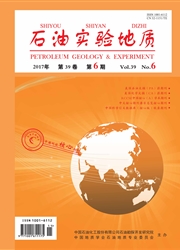

 中文摘要:
中文摘要:
淮南煤田煤层气属于热成因和次生生物成因气的混合气。不同矿区和不同煤层中煤层气的δ^13C1值有明显的不同,这主要是由于现今淮南煤田的煤层气藏中后期生成的次生生物气与残留在煤层中的热解气混合比例不同造成的。研究显示,淮南煤田煤层气的δ^13C1值明显轻于我国热成因煤型气和世界主要地区煤层气的δ^13C1值,表现出了含次生生物成因煤层气的δ^13C1值的变化特征;而δ^13C2值明显与我国热成因煤型气和世界主要地区煤层气的δ^13C2值处于同一分布范围,表现出了热成因气δ^13C2值的特征。淮南煤田煤层气的δ^13CCO2值反映出煤层气中的CO2主要为煤热解而来,部分是次生生物气生成过程中,经过了微生物的还原作用而残留的CO2。
 英文摘要:
英文摘要:
Coalbed gases in Huainan coal field is a gas mixture resulted from thermogenic methane and secondary biogenic gas.And the δ^13C1 value of coalbed gases is very different among different mines and coal beds.This is mainly because the difference of mixing proportion between the remaining pyrolysis gas from coalbed and the secondary biogenic gas from post-stage in Huainan coal field.Compared with Chinese thermogenic coalbed gases and others from the world's major regions by δ^13C1 and δ^13C2 values,it is showed that the δ^13C1 value from Huainan coal field is much smaller.The variational property of δ^13C1 value is characterized by containing secondary biogenic gas.However,the distribution of δ^13C2 value in Huainan coal field is obviously in same position with the one that from Chinese thermogenic coalbed gases and the world's major regions,and it is characterized by property of thermogenic methane.And from the δ^13CCO2 value of coalbed gases,we can inferred that CO2 in methane is mainly resulted from coal pyrolysis,and part of it is the remaining CO2 from microbial reduction occurring in the secondary biogenic gas generating process.
 同期刊论文项目
同期刊论文项目
 同项目期刊论文
同项目期刊论文
 期刊信息
期刊信息
